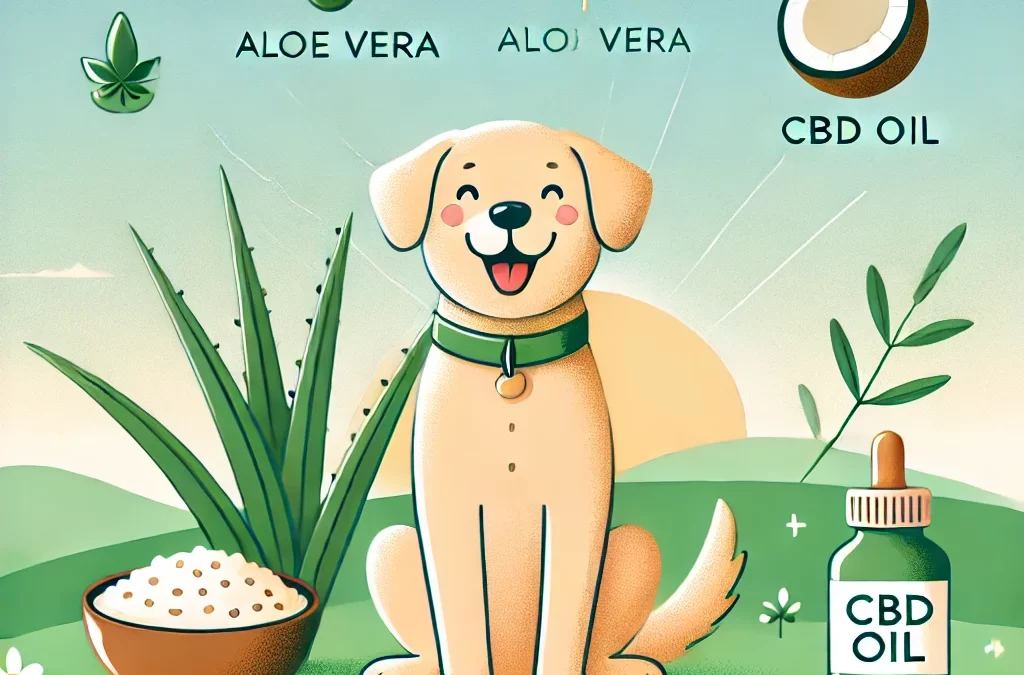
deur TCMVET | okt 28, 2024 | Voedsel & Gezondheid
A shiny, well-kept coat is often the first indicator of a dog’s overall health. For pet owners, it’s not only aesthetically pleasing but also a sign that their dog’s diet provides the essential nutrients necessary for optimal skin and coat health. Key among these nutrients are omega-3 and omega-6 fatty acids, which help maintain a strong, glossy coat and healthy skin.
Omega Fatty Acids and Their Role in Dog Health
- Omega-6 Fatty Acids – Omega-6s are essential for dogs, supporting healthy cell function, hydration, and resilience against external factors. They play a significant role in skin moisture, which translates to less dryness and flakiness. Without adequate omega-6s, a dog’s skin may become dry and prone to irritation, leading to dull, brittle hair that’s prone to breakage.
- Omega-3 vetzuren – Omega-3s provide anti-inflammatory properties that are particularly beneficial for dogs with sensitive skin or those prone to allergies. These fatty acids help reduce itching, redness, and irritation by calming inflammation in the skin. Omega-3s are especially useful during winter months when low humidity levels can contribute to dry skin and discomfort.
Benefits of Balanced Omega Fatty Acids for Dogs
When included in balanced proportions, omega-3 and omega-6 fatty acids contribute to:
- A Lustrous Coat – Omega fatty acids help keep the skin nourished, reducing dryness and ensuring the hair grows with a healthy sheen. This results in a coat that is smooth, shiny, and less likely to shed excessively.
- Reduced Inflammation and Itching – Dogs with allergies or sensitive skin benefit from the anti-inflammatory effects of omega-3s, which help reduce common symptoms like itching, redness, and irritation.
- Stronger Hair and Reduced Shedding – Healthy, hydrated skin promotes strong hair growth, making the coat less prone to breakage and shedding. A balanced intake of fatty acids ensures that hair stays anchored and vibrant.
Natural Sources of Omega Fatty Acids for Dogs
Many high-quality dog foods include omega fatty acids in their formulas, sourced from ingredients like fish oil, flaxseed, and chicken fat. These ingredients provide a natural way to support skin and coat health without artificial additives. Additionally, supplements like fish oil or salmon oil can be added to your dog’s diet to enhance omega-3 intake, especially for dogs with specific skin conditions.
How to Choose Omega-Boosted Foods
When selecting dog food or supplements, look for products that list omega-3 and omega-6 fatty acids on the label. It’s essential to choose brands that use natural sources, as these are better absorbed and more effective in promoting overall skin and coat health. Consulting your vet can also help ensure the right balance of fatty acids, especially if your dog has specific skin concerns.
A dog’s coat health is more than just skin-deep. By including a proper balance of omega-3 and omega-6 fatty acids in your dog’s diet, you can support healthy skin, reduce inflammation, and promote a shiny, beautiful coat. Providing this nutritional foundation helps keep your dog looking and feeling their best year-round.

deur TCMVET | okt 28, 2024 | Voedsel & Gezondheid
Ensuring your dog receives a balanced diet is fundamental for maintaining their health, energy, and happiness. Dogs, like humans, rely on an array of essential nutrients, such as proteins, carbohydrates, fats, vitamins, minerals, and water. Each of these nutrients plays a specific role, from energy provision to disease prevention. By understanding these nutritional needs, pet owners can make informed choices for their pets’ well-being.
Nutritional Needs Vary by Age and Health
Just as humans have different dietary requirements throughout life, so do dogs. Puppies, for example, require more protein to fuel their growth, while adult dogs need a stable balance of all nutrients to maintain health and energy. Specially formulated diets for senior dogs are also available, focusing on easier digestion and joint support. In addition, some dog foods address specific health concerns, such as skin sensitivities, digestive issues, or allergies.
Core Nutrients and Their Benefits for Dogs
- Proteins – Proteins are vital for muscle growth, tissue repair, and immune support. Active dogs benefit greatly from protein, as it aids in muscle maintenance and energy.
- Fats – Fats are a concentrated energy source, supporting brain health, skin, and a shiny coat. Essential fatty acids like Omega-3 and Omega-6 are known to reduce inflammation, support joint health, and enhance the immune system.
- Koolhydraten – Carbohydrates provide energy for daily activities, especially for energetic dogs. Fiber from carbohydrates also promotes digestive health, preventing common issues like constipation or bloating.
- Vitaminen en mineralen – Essential vitamins and minerals, such as calcium and Vitamin E, support bone strength, cell protection, and muscle and nerve function. These nutrients are necessary in small amounts, yet they are integral to your dog’s overall well-being.
- Water – Water is often the most overlooked nutrient but is crucial for maintaining bodily functions. A well-hydrated dog will have better digestion, circulation, and temperature regulation.
Choosing a Dog Food that Suits Your Pet’s Needs
Selecting the right food means considering your dog’s age, size, activity level, and any health conditions. Reading ingredient labels and choosing products with high-quality ingredients, like real meat and natural sources of vitamins, helps in providing optimal nutrition. If your dog has special needs, consult with a veterinarian to find a diet that supports their unique health goals.
Tips for Maintaining a Balanced Diet
Maintaining a balanced diet also involves avoiding overfeeding or excessive treats, as these can lead to weight gain and nutrient imbalances. Regular vet check-ups are important to adjust the diet as your dog’s needs change, especially as they grow older.
A balanced, nutrient-rich diet is the cornerstone of good health and longevity for dogs. From the essential energy provided by proteins and fats to the disease-fighting power of vitamins and minerals, each nutrient contributes to your dog’s well-being. By choosing a diet that aligns with your pet’s specific needs, you can help them lead a vibrant and healthy life.

deur TCMVET | 25 okt. 2024 | Voedsel & Gezondheid
Wanneer een hond te maken heeft met een tumor, neemt zijn energiebehoefte aanzienlijk toe, waardoor dieetaanpassingen essentieel zijn voor zijn gezondheid. Een zorgvuldig gepland dieet kan de immuunfunctie van uw hond ondersteunen, spiermassa behouden en energieniveaus in evenwicht houden. Hier zijn enkele dieetrichtlijnen die gunstig kunnen zijn voor honden met tumoren.
1. Hoge voedingsdichtheid
Honden met tumoren ervaren vaak een hoger dan normaal energieverbruik vanwege de inspanningen van het lichaam om de kankercellen te bestrijden. Dit vereist een dieet dat rijk is aan voedingsrijke, gemakkelijk verteerbare voeding. Voedingsdichtheid zorgt ervoor dat uw hond essentiële vitaminen, mineralen en energie binnenkrijgt zonder zijn systeem te overbelasten met lege calorieën. Voedingsmiddelen met een hoge voedingswaarde zijn essentieel omdat ze de benodigde energie en voedingsstoffen leveren in kleinere, beter beheersbare porties.
Aanbevolen voedingsmiddelen: Mager vlees, eieren, orgaanvlees (zoals lever) en groene groenten.
2. Vermijd koolhydraten met veel koolhydraten
Omdat tumorcellen voornamelijk glucose gebruiken voor energie, is het cruciaal om de inname van koolhydraten te verminderen. Koolhydraten worden in het lichaam omgezet in glucose, wat de groei van tumoren stimuleert. Door koolhydraten te beperken, kunt u de groei van tumorcellen mogelijk vertragen en de energievoorziening verlagen waar kankercellen afhankelijk van zijn.
Aanbevolen vervangingen: In plaats van koolhydraatrijke voedingsmiddelen zoals granen en zetmeelrijke groenten, kunt u beter kiezen voor bladgroenten, magere eiwitten en gezonde vetten.
3. Verhoog de kwaliteit van vetten en eiwitten
Vetten en eiwitten zijn cruciale componenten van een kankervriendelijk dieet voor honden. Gezonde vetten, zoals die in visolie en kokosolie, leveren aanhoudende energie en ondersteunen de immuunfunctie. Ondertussen zijn hoogwaardige eiwitten essentieel voor het behoud van spiermassa en lichaamsgewicht, die snel kunnen afnemen bij honden met tumoren. Eiwitten helpen het lichaam ook weefsels te herstellen en hormonen te produceren die essentieel zijn voor de immuungezondheid.
Aanbevolen bronnen van gezonde vetten en eiwitten:
- Gezonde vetten: Kokosnootolie, visolie, lijnzaadolie
- Hoogwaardige eiwitten: Kip, kalkoen, mager rundvlees, vis en eieren
Laatste overwegingen
Raadpleeg een dierenarts of een hondenvoedingsdeskundige om een dieet op maat te maken dat voldoet aan de specifieke behoeften van uw hond. Ga langzaam over om spijsverteringsproblemen te voorkomen en houd hun reactie op dieetveranderingen in de gaten. Met het juiste voedingsplan kunt u de algehele gezondheid van uw hond ondersteunen en hun kwaliteit van leven verbeteren, zelfs als ze met gezondheidsproblemen te maken krijgen.

deur TCMVET | okt 16, 2024 | Voedsel & Gezondheid
Rashes in dogs are more common than you might think, and they can range from mild irritations to severe skin conditions. But what if traditional treatments don’t work, or you’re looking for more natural options? Here’s a fresh take on dog rash treatment that blends innovative care strategies with tried-and-true methods to help your dog recover faster and more comfortably.
1. Understanding the Root Cause
Before diving into treatment, it’s crucial to identify the underlying cause of your dog’s rash. Rashes can be triggered by several factors:
- Allergies: Environmental allergens (pollen, dust), food, or flea bites.
- Infecties: Bacterial, fungal, or parasitic infections can irritate the skin.
- Autoimmune Disorders: These are rare but can cause persistent skin issues.
By pinpointing the cause, you’ll be better equipped to treat the rash effectively. Consulting your vet is essential to getting a clear diagnosis, but there are innovative ways to manage the symptoms at home.
2. Aloe Vera: The Natural Skin Soother
Aloe Vera is known for its cooling and anti-inflammatory properties, making it an excellent remedy for dog rashes. Use pure aloe vera gel (without additives) and apply it gently to the affected area. It can reduce itching, redness, and irritation, offering instant relief for your pet.
3. Oatmeal Baths: A Time-Tested Remedy with a Twist
Oatmeal baths are often recommended for dogs with skin conditions, but you can elevate this simple solution by adding green tea to the bathwater. Green tea has natural antioxidants that can calm inflamed skin and boost the immune system. Combine finely ground oatmeal with brewed green tea for a bath that soothes irritation and promotes skin healing.
4. Coconut Oil: Beyond Hydration
Coconut oil is another versatile remedy for dog rashes. While its moisturizing properties are widely known, it also has antibacterial and antifungal effects. Applying coconut oil to the rash can help prevent infection while keeping the skin hydrated. For an added boost, mix a few drops of lavender essential oil, which can help reduce itchiness and further soothe inflamed skin.
5. CBD Oil: A Modern Marvel
CBD oil has gained popularity for its anti-inflammatory and calming properties. Topical application of CBD oil on dog rashes can help reduce discomfort and itching. It interacts with the dog’s endocannabinoid system, which is involved in maintaining skin health. CBD oil can be an alternative to conventional medications that sometimes cause side effects.
6. Dietary Adjustments: Treating Rashes from the Inside Out
Sometimes, skin conditions like rashes are a symptom of food sensitivities. Consider switching to a hypoallergenic diet or incorporating omega-3-rich supplements like visolie into your dog’s meals. Omega-3s help reduce inflammation and promote healthy skin and coat, working from the inside to alleviate rashes.
7. Probiotics for Skin Health
Did you know your dog’s gut health plays a significant role in their skin condition? Introducing probiotica can help balance gut bacteria and improve overall immune function. A healthy gut can mean healthier skin and fewer rashes, especially if your dog suffers from allergies or immune-related skin issues.
8. Preventing Future Rashes: Practical Tips
Prevention is key to avoiding recurring skin issues. Here’s how you can help your dog stay rash-free:
- Regelmatige verzorging: Brushing your dog regularly helps remove allergens, dead skin, and loose fur.
- Flea Prevention: Invest in high-quality flea preventatives to reduce the risk of flea bites, which often lead to rashes.
- Proper Hygiene: Keep your dog’s bedding clean and wash their toys and collars regularly.
Conclusion: Holistic Approach to Dog Rash Treatment
When it comes to treating dog rashes, there’s no one-size-fits-all solution. By combining traditional treatments with innovative and natural remedies, you can offer your dog effective relief while supporting their overall health. Whether you’re using soothing aloe vera, powerful CBD oil, or probiotics, these modern strategies go beyond the typical solutions, ensuring your dog’s comfort and speedy recovery.

deur TCMVET | okt 15, 2024 | Voedsel & Gezondheid
Dog allergies are a common but often overlooked health issue. Just like humans, dogs can suffer from allergic reactions to a variety of triggers, including food, environmental factors, and even fleas. These allergies can manifest as skin problems, gastrointestinal disturbances, and other signs of discomfort. Recognizing the symptoms early and taking appropriate measures to manage them is crucial for your pet’s health. In this article, we will explore the different types of dog allergies, their symptoms, and practical steps you can take to treat and prevent allergic reactions.
Types of Dog Allergies
- Environmental Allergies
Dogs can develop allergies to airborne particles such as pollen, dust mites, mold, and even chemicals in cleaning products. These allergens can cause a range of symptoms, from sneezing and coughing to itchy, inflamed skin. Seasonal allergies are common and can worsen during specific times of the year, such as spring or fall.
- Food Allergies
Certain ingredients in your dog’s diet, especially proteins like chicken, beef, or dairy, can trigger allergic reactions. Unlike environmental allergies, which are usually seasonal, food allergies can cause year-round symptoms like itchy skin, ear infections, and gastrointestinal issues like vomiting and diarrhea. If you suspect your dog has a food allergy, an elimination diet can help identify the problematic ingredient.
- Flea Allergy Dermatitis
Fleas are more than just a nuisance; they can cause severe allergic reactions in dogs that are hypersensitive to flea saliva. Even a single flea bite can lead to intense itching, skin inflammation, and hair loss. Flea control is essential for dogs prone to flea allergy dermatitis.
Common Symptoms of Dog Allergies
- Skin Irritation and Itching
The most noticeable symptom of allergies in dogs is itchy skin, particularly around the face, ears, paws, and belly. Constant scratching, licking, or biting at these areas can lead to redness, sores, and hair loss.
- Chronic Ear Infections
Recurrent ear infections are a common sign of allergies, especially in dogs with food sensitivities. You might notice your dog shaking its head, scratching its ears, or producing a foul-smelling discharge.
- Gastro-intestinale problemen
In dogs with food allergies, symptoms can extend beyond the skin to the digestive system. Chronic diarrhea, vomiting, bloating, and a reduced appetite are common signs. These symptoms can be mistaken for other gastrointestinal disorders, so it’s important to monitor them closely.
- Ademhalingsproblemen
Although less common, some dogs may show respiratory symptoms such as coughing, sneezing, or wheezing, particularly in response to environmental allergens like pollen or dust.
Treating Dog Allergies
- Identify the Allergen
The first step in managing dog allergies is to identify the specific allergen. For food allergies, this often involves an elimination diet, where suspected allergens are removed and gradually reintroduced. For environmental allergies, allergy testing can be performed by a veterinarian to pinpoint the exact trigger.
- Switch to a Hypoallergenic Diet
For dogs with food allergies, a hypoallergenic or limited-ingredient diet can prevent allergic reactions. These diets use novel proteins and carbohydrates that your dog has likely never been exposed to, reducing the chance of an immune response.
- Medicijnen en supplementen
In cases of severe allergic reactions, antihistamines, corticosteroids, or other medications may be necessary to relieve symptoms. Omega-3 fatty acids, found in fish oil supplements, can also help reduce inflammation and improve skin health.
- Flea Control
Preventing flea infestations is critical for dogs with flea allergies. Regular use of flea preventatives such as spot-on treatments, flea collars, or oral medications can help keep fleas at bay. Regular grooming and vacuuming of your home can also reduce the likelihood of a flea outbreak.
- Milieu management
Reducing exposure to environmental allergens can be as simple as keeping your home clean, using air purifiers, and washing your dog’s bedding regularly. During high-pollen seasons, wipe your dog’s paws and fur after walks to reduce contact with outdoor allergens.
Dog allergies can range from mild to severe, but with the right care and treatment, most dogs can live comfortably and healthily. Whether your dog suffers from food allergies, environmental allergens, or flea allergy dermatitis, understanding the symptoms and treatment options will help you provide the best possible care. If you suspect your dog is suffering from allergies, consult your veterinarian for a proper diagnosis and personalized treatment plan.

deur TCMVET | okt 15, 2024 | Voedsel & Gezondheid
Digestive issues in dogs, such as intermittent vomiting, loose stools, and excessive gas, are common concerns for many pet owners. These issues may arise due to dietary imbalances, underlying health problems, or even individual sensitivities. Identifying the root cause of your dog’s gastrointestinal (GI) upset is crucial to improving their overall health and well-being.
Common Dietary Causes of Digestive Problems in Dogs
- High Fat Content
A diet that contains too much fat can overwhelm your dog’s digestive system, leading to loose stools and vomiting. Fat is more difficult to digest, so dogs with sensitive stomachs may struggle to process it properly. Reducing fat intake and opting for leaner protein sources may help alleviate digestive issues.
- Insufficient Fiber
Fiber plays a critical role in maintaining healthy digestion by promoting regular bowel movements and supporting gut health. Diets lacking in fiber can lead to inconsistent stools and digestive discomfort. Adding fiber-rich ingredients, such as pumpkin or sweet potato, may provide relief.
- Food Intolerances or Allergies
Some dogs may have food sensitivities or intolerances, especially to common allergens like grains, dairy, or certain proteins (e.g., chicken or beef). Identifying the offending ingredient through an elimination diet can prevent digestive upsets in the future.
- Overeating or Rapid Eating
Dogs that eat too quickly or consume large amounts of food may experience bloating and indigestion. Slowing down mealtime with puzzle feeders or smaller portions can help reduce these symptoms.
Underlying Health Disorders
While diet plays a major role in digestion, other health conditions may also contribute to GI upset. Pancreatitis, bacterial overgrowth, or intestinal parasites can cause chronic digestive problems. Consulting with a veterinarian to rule out underlying conditions is essential when persistent symptoms occur.
How to Choose the Best Food for a Dog with a Sensitive Stomach
- Opt for Easily Digestible Ingredients
Choose dog foods that contain simple, high-quality ingredients, such as lean proteins (e.g., turkey, lamb, or fish) and whole grains like brown rice. These are gentler on your dog’s stomach and easier to digest.
- Look for Limited Ingredient Diets (LID)
LID dog foods contain fewer ingredients, reducing the risk of triggering a food sensitivity or allergy. They focus on high-quality protein and limited sources of carbohydrates, making them ideal for dogs with sensitive stomachs.
- Consider Probiotics and Prebiotics
Adding probiotics to your dog’s diet can help balance gut bacteria and promote healthy digestion. Prebiotic fibers, found in foods like chicory root or beet pulp, also support the growth of beneficial bacteria in the gut.
- Vermijd kunstmatige toevoegingen
Avoid dog foods that contain artificial preservatives, colors, or flavors, as these can exacerbate digestive issues. Opt for natural, preservative-free options whenever possible.
Every dog has unique dietary needs, and what works for one dog may not be suitable for another. Understanding common causes of digestive issues and making appropriate changes to your dog’s diet can significantly improve their digestive health. Always consult with a veterinarian before making major dietary adjustments, especially if your dog shows signs of chronic digestive problems.







